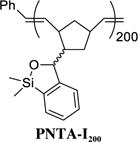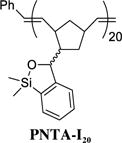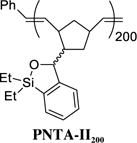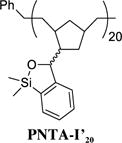Table 2.
Structure-Activity of Siloxane Polymer in Cross-Coupling Reactionsa

| |||
|---|---|---|---|
| entry | siloxane polymer | time |
1H-NMR resultsb (6 : 5 : 7) |
| 1 |

|
2 h | 100 : nd : <1c |
| 2 |

|
2 h | 80 : nd : 20 |
| 3 |

|
50 h | 1 : 99 : nd |
| 4 |

|
20 h | 42 : 33 : 25 |
| 5d |

|
20 h | 6 : 94 : nd |
| 6 |

|
2 h | 83 : nd : 17 |
All reactions were performed on 0.3 mmol scale using 2.5 equiv PhLi, 3.0 equiv siloxane polymer, 3 mol % PdCl2, 4 mol % dpca, 10 mol % CuI.
Determined by 1H-NMR analysis of the reaction mixture following an aqueous workup, extraction with Et2O and polymer removal via precipitation in CH3CN.
98% yield of 6.
The insoluble polymer was stirred heterogeneously in reaction mixture. nd = not detected.
